For those planning a holiday in the Italian Lakes, this A to Z guide to the many beautiful towns and villages on Lake Como should provide you with all the holiday reading you need ahead of your stay, making sure you hit the ground running!
Argegno
A truly authentic village on the shores of Lake Como, Argegno revolves around its central square, Piazza Roma. Despite having only around 600 permanent inhabitants, the village is blessed with a number of superb restaurants, many of which enjoy lake views. It’s a charming village characterised by narrow cobbled streets.
Keep an eye out for the bust of Italian engineer Pietro Vassena on the shore front. Back in March 1948, he touched the bottom of the lake 410 metres below the surface in his self designed C3 submarine. At the time this set a new world record as no other submariner had ever reached that depth before.
Also look out for the 17th century Church of Santissima Trinita on your travels whose facade has a striking mosaic depicting Matthew, Mark, Luke and John along with Sant’ Abbondio (the patron saint of Como) and Sant’ Anna (the patron saint of Argegno).
To enjoy a slightly different perspective on Argegno, take a cable car ride 540 metres up the mountainside to Pigra from where you’ll enjoy wonderful views over the village and surrounding area. Or, alternatively, for another great view, take a walk across the Roman bridge that takes you from the marina and the via Lungo Telo di Sinistra. Head to Argegno on a Monday to enjoy the weekly morning market.
Bellagio

Arguably Lake Como’s most famous town, Bellagio is extremely pretty. Narrow alleyways and cobbled streets are festooned with flowers that spill over from the window boxes above. Its most famous visitor attractions are the Villa Melzi and Villa Serbelloni, both grand villas that boast beautiful gardens that the public are welcome to explore.
Like with so many of Lake Como’s towns, Bellagio can boast some great viewpoints too. Head either to the very tip of the village (Punta Spartivento) in the middle of the three branches of Lake Como or instead follow the pathway and steps signposted Salita Cappuccini to Pescallo where you’ll enjoy a view down over the town.
Check out our Bellagio travel guide for more information.
Bellano
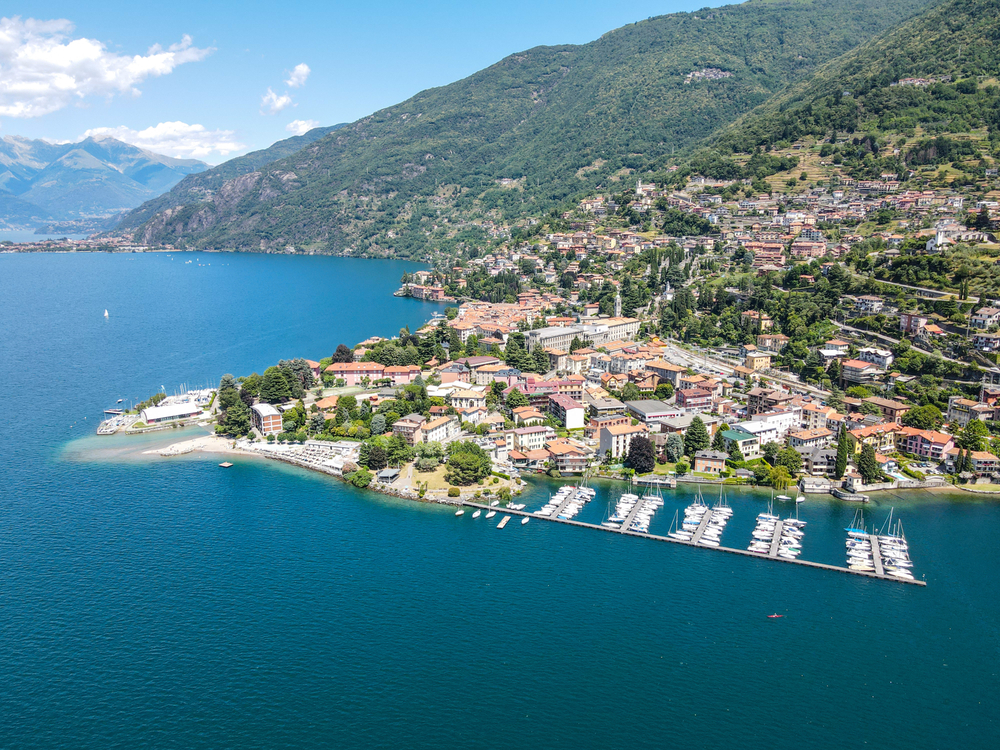
Bellano has had a rich and rather dramatic history and, in the past, has frequently been the site of battles, for example during the 12th century wars between Como and Milan as well as the wars between the Visconti and Venice in the 15th century and then between the Medeghino and Sfoza in the 16th century. These days, it is probably most famous for its ravine (l’orrido) which was formed over millions of years by the waters of the Pioverna River which essentially created a deep ravine that now stretches from Taceno to Bellano. The canyon is accessed via a series of suspension bridges and there are hiking tails allowing you to explore the gorgeous landscape around the town.
Bellano itself is a very attractive lakeside town and has a charming lake front with pebbled beaches and a number of places where you can swim in the lake. It’s well worth a visit to explore the narrow alleyways that lead between the Medieval houses and baroque courtyards. The village is also home to numerous churches. The oldest of these is the 13th century church of Saint Nicolao. This has since been deconsecrated but is still home to some lovely 14th century frescoes. The 14th century church of St Nazzario and St Celsio is probably the most interesting, designed by Giovanni Campione and with a striking black and white Gothic facade and a big rose window. Also of note is the later 15th century church of Santa Marta.
Blevio
The town of Blevio is comprised of seven hamlets, also known as the ‘seven cities’ – Girola, Meggianico, Sorto, Mezzovico, Capovico, Sopravilla and Cazzarone. It is an ancient town dating back as far as the Iron Age and sits just a few kilometres east of Como. It is home to some stunning private residences and is now also where you will find the prestigious Mandarin Oriental hotel, Castadiva.
Brienno
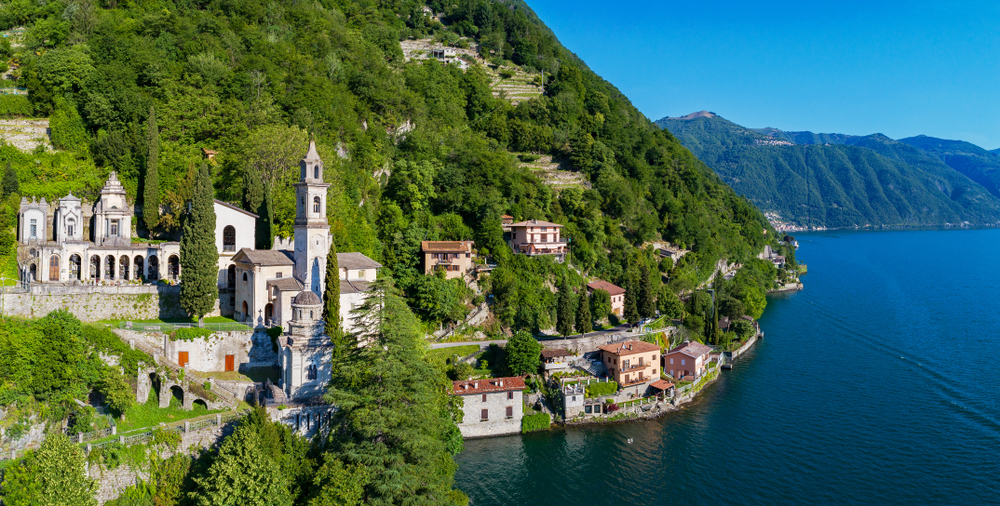
A charming Medieval village and a real gem to visit, Brienno’s streets are extremely narrow. In fact the alleyways and steps barely separate the old stone houses on each side, whose window boxes and balconies are filled with flowers. Some of these houses literally have their feet in the lake waters below.
Brienno’s most striking building is the Romanesque church of San Vittore. Its bell tower is tall and slender and is easy to pick out from Brienno’s skyline. Otherwise, there are a small number of shops and restaurants in the town and a pretty central piazza.
Brunate
Affectionately known as the ‘balcony of the Alps’, Brunate sits 700 metres above sea level. The easiest way to reach it is to take a funicular ride from Como up the mountainside, passing a number of late 19th and early 20th century Art Nouveau villas en route. Running approximately every 10 minutes, the single track railway has been taking visitors up and down the hillside since 1894 . Once at the top, you’ll be able to enjoy a wonderful view over Como and the lake. If you want to venture a little further from here, you’ll be rewarded with even more impressive views at the nearby Volta lighthouse.
Cadenabbia
A little village on the shores of Lake Como, the story goes that centuries ago, Cadenabbia was home to a tavern where boatmen used to stop en route from Como and Lecco. This tavern became the area’s first hotel in the early 19th century and the village has been attracting holidaymakers ever since, lured by the sheltered climate and charming tree-lined waterfront.
The village can also lay claim to being home to the first Anglican Church to be consecrated in Italy in 1891, a reflection of the popularity of the town among Brits. However, that’s not its only claim to fame. Mary Shelley stayed in Cadenabbia and describes it in her book Rambles in Germany and Italy. It’s also said that Verdi composed some parts of La Traviata while staying in Cadenabbia. You can actually walk north along the lakeside to see the 18th century villa in which he stayed – Villa Margherita. Another nice walk is from the Piazza San Rocco through the fields and woodland to the church of San Martino from where the views over Lake Como are second to none. Or, head south along the waterfront to Tremezzo instead where you will find the incredible botanical gardens of Villa Carlotta. Or, opt for the longer 10 km walk – the Greenway of Como – from Cadenabbia to Colonno.
The lakeside promenade is very pretty and, from here, visitors can enjoy superb views across the waters to Bellagio. There is also a good selection of cafes and restaurants here as well as an open air swimming pool at the Lido di Cadenabbia.
Careno
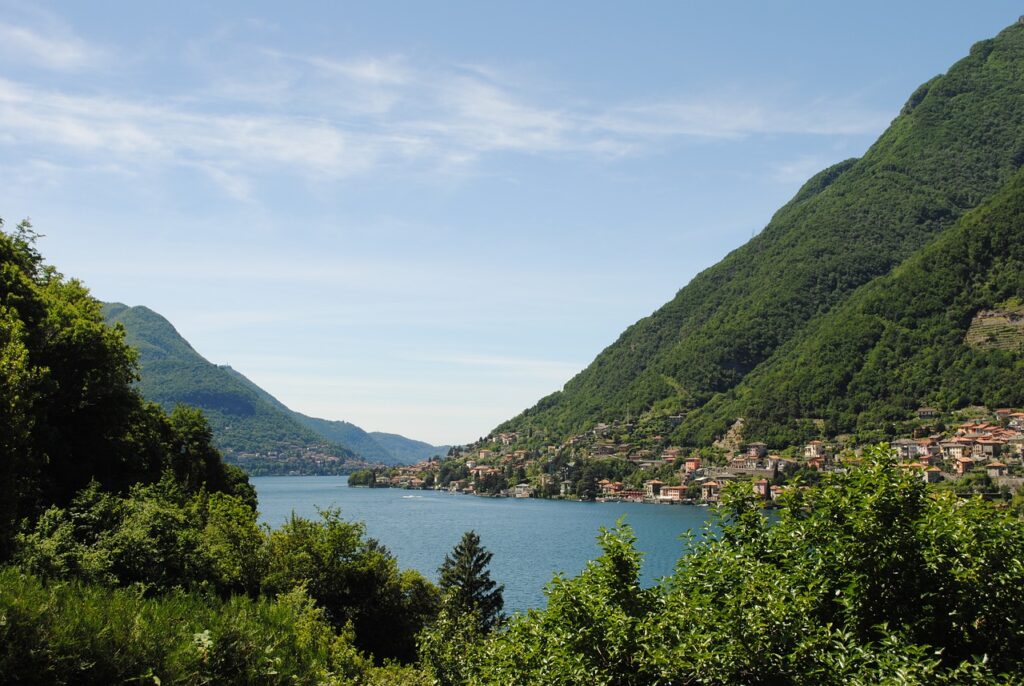
Careno is a picturesque village comprised of nothing more than a handful of houses, a church, a small harbour and an excellent trattoria! The houses are built from the local moltrasina stone thanks to the local quarries that used to be nearby. From the water, its shape is rather unusual, appearing to sit almost upside down when compared to the other towns and villages. In fact, its upside down triangular shape has earned it the affectionate and rather amusing nickname of ‘the bikini village’! From the road, it’s pretty much invisible.
The village is home to two churches – the 17th century Church of the Assumption and the earlier 12th century Romanesque Church of San Martino which overlooks the lake. If you’d like to have the chance to go inside the latter, then speak to the wonderful owners of the nearby (and rather excellent) Trattoria del Porto in Careno who are the key holders. Inside you’ll discover some rather impressive 16th century frescoes but, even if you’re not interested in the art, its worth heading to its portico at the entrance that overlooks the lake. And make sure you leave time to enjoy a meal at the restaurant too! Family owned, it serves up excellent local cuisine.
If you’re feeling energetic, take a walk uphill to Monti di Careno, sitting 360 metres above sea level on the slopes of Monte Preaola. You’ll discover some idyllic scenery there. Or continue on and you’ll reach the Masera caves filled with waterfalls, ponds, pools and tunnels. These can be explored in the company of an expert guide. Alternatively, spend some time simply relaxing on Careno’s sandy and grassy beach.
Cernobbio
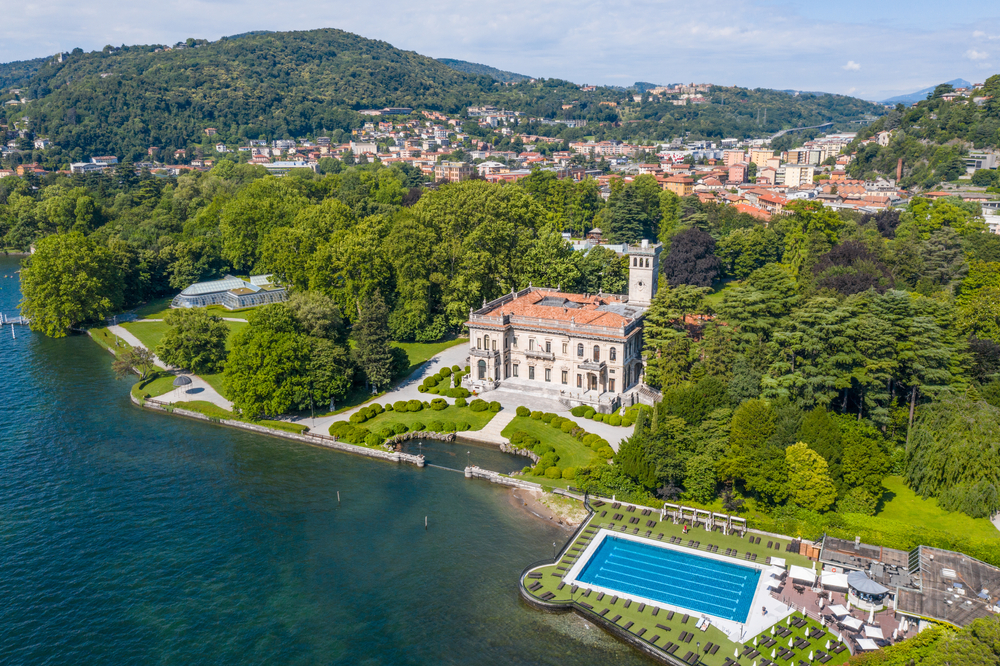
Cernobbio is definitely most famous for being home to some of Lake Como’s most famous historic villas – Villa Bernasconi, Villa d’Este and Villa Erba. The latter dates back to 1898 whilst the origins of Villa d’Este stretch further back to 1589 when it was known as the Villa del Garrovo after the nearby river that flows into Lake Como. The name was changed in 1814 when the villa was purchased by the Princess of Wales who believed herself to be a descendant of the Este family. These days the Villa d’Este is one of the world’s most luxurious hotels. If you can’t afford the expensive price tag of a night here, then you can still admire the building and gardens from the water via a boat trip. In contrast, Villa Bernasconi is open to the public should you wish to explore this historic villa.
Take time to walk along the beautiful lakeside promenade too, (known as the the Riva di Cernobbio), past its fountains and beaches, across the Art Nouveau bridge and through the Giardino della Valle. Until not that long ago, this was an area of wasteland but has been transformed into an exquisite garden. Move from here through to the charming old town of Cernobbio, through streets lined with colourful houses, elegant shops and excellent restaurants. Head to Cernobbio on a Wednesday morning to make the most of the weekly market. Also of note in the town are some of Cernobbio’s churches including the Parrochiale Primitiv, dedicated to Saint Vincenzo and the Church of Santa Stefano. Sitting in a slightly elevated position above the town, this church enjoys lovely views down over the lake.
And, if you fancy a longer walk, then Cernobbio also marks the start of the Lariani Mountain walk (Via dei Monti Lariani). This walking trail is a beautiful 80 mile walk marked out by the Italian Alpine Club. It will take you to Monte Bisbino, 1325 metres above sea level where you will find a 16th century sanctuary. And continue on and you will reach the Buco della Volpe cave, eventually finishing in Sorico. You’ll need to be fit to complete it and be prepared for challenging tracks in places.
Colico
Colico is a lovely village dating back to Roman times. These days, it’s a popular holiday resort, with visitors attracted by three beaches – a lido at the west of the town, a surf beach in the east and Piona bay in the Laghetto district. It’s a good place to enjoy water sports including surfing, sailing, wakeboarding, kite surfing and water skiing. There is even an opportunity to go scuba diving near Colico at the Parco Subacqueo of Piona.
Whilst visiting Colico, make sure you take a trip to the 13th century Piona Abbey. The abbey enjoys panoramic views and is still inhabited by monks who grow herbs, plants and vegetables to create herbal remedies, cures and liqueurs using century old recipes and techniques. Also worth a visit is the 17th century Forte Fuentes and early 20th century Forte Montecchio Lusardi. The latter was built just two years before WWI and is still equipped with its cannons. Also of note is the late 14th century Torre di Fontanedo and the Oratorio di S. Rocco.
Como
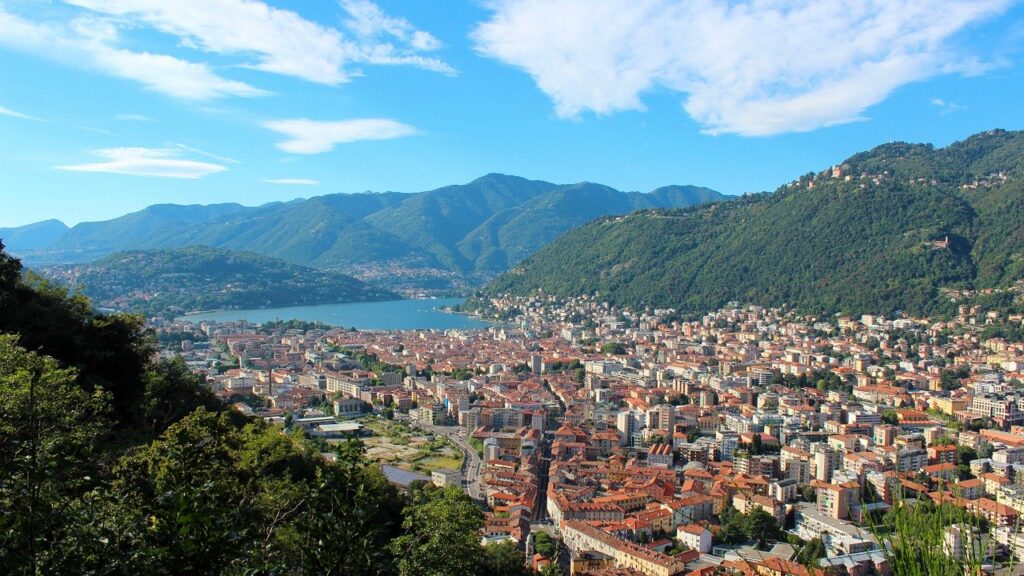
Lake Como’s largest town, Como sits at the southern tip of the lake. There is plenty to see and do in the town. It offers some great shops (including plenty of designer brands) along with beautiful churches, gardens and museums. Don’t miss the opportunity to visit the Duomo, the Basilica of Saint Addondio, the Teatro Sociale and the Broletto (the Medieval town hall) during your stay.
For a different perspective on Como, take a funicular ride from Como up the mountainside to the small village of Brunate. Enjoy the fantastic views over the town from one of the many terraces here or venture a little further on to the Volta lighthouse to enjoy even more spectacular 360 degree views.
Check out our complete Como travel guide for further information about what to see and do in the city.
Dervio
Dervio’s origins stretch as far back as Celtic and Roman times however its heyday was arguably during its time under Austrian occupation when it boomed thanks to a number of industries including paper mills and shipbuilding. Its long history can be seen in the many historic buildings still present in Dervio today. These include the Medieval Orezia Castle. Today, only its tower and the ruins of its walls remain but it’s still well worth a visit. Dervio’s second castle is the 5th century Castelvedro Castle, situated 500 metres above sea level in the tiny hamlet of Maialso.
Also of note are a number of churches in Dervio. The first of these is the Church of San Leonardo, home to a series of 15th century frescoes. Also of note is the Church of Saints Quirico and Giuditta with its elegant 11th century bell tower. With parts dating back to 814 AD, this is one of the oldest religious buildings in the area. The lakeside 11th century Romanesque church of San Pietro and Paolo is also worth visiting. Also at the lakeside is the neoclassical dock designed by the famous architect Luigi Cagnola.
These days, Dervio’s position on Lake Como is also ideal for water sports earning it the affectionate nickname ‘paradiso della vela‘ (sailing paradise) and there are a number of excellent water sports centres here. It’s also a popular spot for walkers, hikers and climbers.
Head to the town in July to enjoy the annual International Animation Cinema and Comic Book Festival (Festival Internazionale Cinema d’Animazione e Fumetto).
Domaso

The ancient fishing town of Domaso is another great location if you’re a fan of water sports including sailing and windsurfing.
It’s also a great spot for wine lovers. The vineyards of nearby Pozzuolo and Gaggio grow the grapes needed for the rare Domasino white wine which is produced in Domaso’s ancient cellars. Annual production is less than 2000 bottles.
Otherwise, it’s worth visiting the 16th century Church of San Bartolomeo. You may also want to take the time to visit Villa Miani, built in the early 19th century by renowned painter Vasques, as well as Villa Camilla which boasts a stunning garden. Visit in the Spring to admire the stunning camellias in bloom.
Dongo
Dongo is arguably most famous for being the place where Mussolini was captured after his attempted escape at the end of WWII. As he tried to make his way to Switzerland, he was recognised by a group of partisans in Dongo on 27 April 1945 and subsequently killed in Azzano. These days, a cross marks the spot where he was executed along with 15 fascist leaders. Visitors can find out more about what happened in the Museo della Fine della Guerra. This is housed in the rather beautiful Palazzo Manzi. Its interior also has some beautiful frescoes of the school of Appiani.
Otherwise, Dongo’s history has revolved for centuries around the iron industry. Iron has been extracted from the mines of the Valle Dogana since the early 15th century and the industry still flourishes today.
Buildings of note that you may want to visit include the 16th century Santuario della Madonna delle Lacrime and the Romanesque Church of Saint Maria of Martinico. This is older than the afore mentioned Sanctuary of the Lady of Tears, dating as far back as the 11th century. Head inside to admire the processional cross made by Francesco di Gregorio in 1513. If you would like to view a third religious building, then take a walk from the village through the nearby village of Barbignano where you will find the Santuario di San Gottardo, Dongo’s patron saint. The Palazzo del Vescovo in Dongo is also rather impressive, restored in the 1980s.
It’s even worth visiting Dongo just to enjoy the views that it can boast towards Bellagio in one direction and Gravedona in the other.
Esino Lario
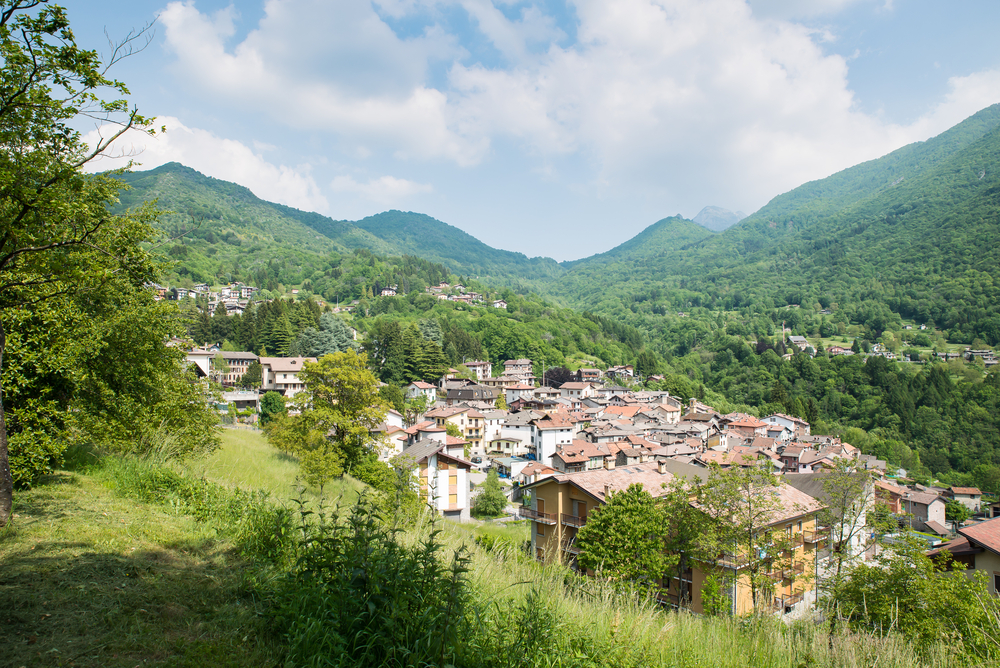
A village in the mountains above Lake Como, Esino Lario sits 910 metres above sea level. It is split between Upper Esino (Esino superiore) and Lower Esino (Esino inferiore). Not surprisingly, it’s a great place to enjoy some fantastic views over the lake below, not least from La Capella di San Pietro in nearby Ortanella. Other churches of note include San Vittore and San Giovanni Battista. It’s also extremely popular with walkers and hikers, attracted by the fresh mountain area and superb climate. Look out for the 2 km long fitness trail which takes you through woodland, meadows, fields and over hills, dotted with various fitness stations en route. For a longer walking route, opt for La Strada del Viandante (Wayfarer’s Road) which is 45 km long and enjoys some incredible views en route. Esino Lario also has a museum – the Museo delle Grigne – where you will find an excellent collection of minerals, fossils and butterflies.
Faggeto Lario
Faggeto Lario is a town comprised of four villages – Riva di Faggeto, Molina, Palanzo and Lemna. Some of the key attractions include an ancient 16th century wine press (il torchio) made from a single tree trunk, an impressive 12 metres long and with a 3 metre circumference. Visit in October during the annual Sagra del Torchio to see it working.
Also of note is the 11th century Romanesque Church of Saint Margaret (Chiesa di Santa Margherita) in Molina and the Chiesa del Soldo (Church of Our Lady of Sorrows). And, for those interested in geology, also nearby is the Grotta Guglielmo.
Grandola ed Uniti
Grandola ed Uniti is most famous for being the site of one of the oldest oak trees in Europe – Il Rogolone – which is around 300 years old, standing over 25 metres tall and with a massive circumference of nearly 8 metres.
Gravedona
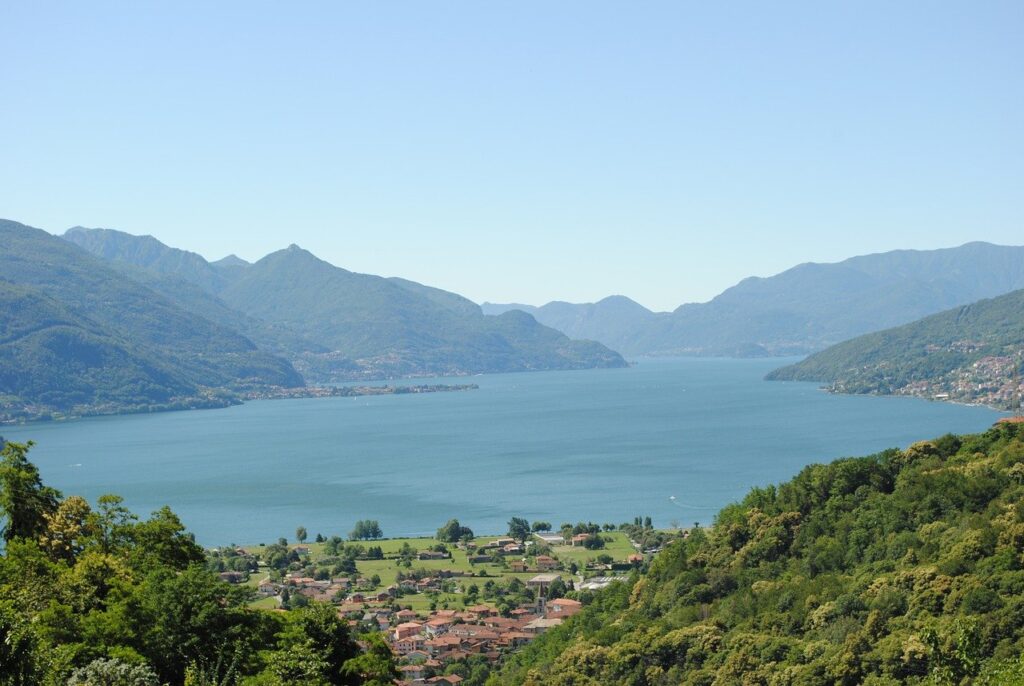
There is lots to see and do in Gravedona (or Gravedona ed Uniti to be precise), situated on Lake Como’s North West shore. A good starting point though is the pretty traffic-free lakeside promenade that stretches along Como’s shores, starting at Viale Stampa. Lined with colourful houses on one side, it’s the perfect place to enjoy a leisurely stroll, stopping at one of the town’s cafes en route. From here, head to the historic town centre and to the Piazza Pra Castello to enjoy the beautiful lake views.
There are a couple of buildings to look out for on your way. The first is very close to the Piazza Pra Castello in the aptly named Via Volta and is the house where Alessandro Volta, the inventor of the battery, spent much of his childhood. You could easily miss the property were it not for the commemorative plaque which adorns the exterior wall. Also of note is the 12th century Romanesque Church of Santa Maria del Tiglio. Its striped facade is quite striking whilst inside it is rather elegant. Make sure to admire the wooden crucifix inside which dates back to the same period and look out for a mosaic depicting a centaur chasing a deer, symbolic of the early persecution of the Christian church.
Other churches you may want to visit include the Church of Santi Gusmeo and Matteo and the Church of Santa Maria delle Grazie, filled with frescoes and which enjoys a wonderful view of the lake. And finally, there is the Palazzo Gallio. Built in 1586 by Bishop Tolomeo Gallio and designed by Pellegrini, it occupies a magnificent setting overlooking the water, its four corner towers adding a real sense of gravitas to the building, whilst its two terraces enjoy spectacular views over the lake to Mount Legnone. Make sure you leave plenty of time to visit the impressive parkland that surrounds the palace.
If you can spare the time, it’s worth taking a wall into the hills behind Gravedona too, to the villages of Germasino, Brenzio and Stazzona. You’ll be rewarded with some fantastic views en route whilst the villages themselves are completely unspoilt and rather charming. The Parco Valle Albano in Gravedona is extremely popular with walkers, hikers, horse riders and cyclists and is home to an incredible variety of wildlife, flora and fauna.
For some more relaxed time in Gravedona, head to the Serenella beach in Viale Scuri. A mix of lawn and sand, it’s a great place to spend a few hours. And if you like water sports, Gravedona is another great place to enjoy sailing, kitesurfing and windsurfing on Lake Como. For those who prefer to be more active on land, head to the Lake Como Adventure Park which is situated in Gravedona ed Uniti. With five different tree-top routes to master, there is something for all the family from the 2 year old to the 90 year old!
Griante
Griante is perhaps most famous for being the setting where Giuseppe Verdi wrote part of his opera La Traviata. However, in the past, the town has hosted many a famous figure. The French writer, Stendhal, used Griante as the setting for his novel The Charterhouse of Parma. And other famous figures have spent time here, from Queen Victoria to Nicholas II and from Pope Pius XII to Kaiser Wilhelm II. No doubt, there are many modern celebrities who continue to choose to holiday here today, lured by its incredibly beautiful views of Como lake. This part of Lake Como is affectionately nicknamed the ‘Riviera of the Azaleas’ and people certainly flock to this area in the Spring to admire the thousands of colourful blooms that spring up.
Isola Comacina
The only island in Lake Como, Isola Comacina is pretty much uninhabited. Three artist’s homes are present on the island though, built by Pietro Lingeri in 1940. The island welcomes visitors between March and October each year.
It plays host to one of Lake Como’s most spectacular events – the Festival of San Giovanni – each June. Each year, there is a procession by boat to the island of Comacina followed by an impressive fireworks display. You’ll find hundreds of boats will try to get a prime spot to view the show in the bay between the island and Ossuccio.
The island has been used as a setting for several films, the most famous of which is probably Alfred Hitchcock’s first film, The Pleasure Garden.
Laglio

Laglio comprises five separate hamlets – Ossana, Germanello, Soldino, Ticee and Torriggia. The latter holds the best claim to fame as being the most narrow point on Lake Como, just 675 metres across from here to the opposite shore.
There is no doubt however that, these days, Laglio is most famous for being the town where George Clooney purchased his villa – Villa Oleandra. Overnight, the once sleepy town attracted thousands of tourists, all hoping for a chance to spot the famous American actor! However, it still remains quiet off season and is worth a visit whatever time of year you’re holidaying here.
We can certainly see what attracted Clooney to the town. Its pastel-coloured houses are rather charming and the lakefront promenade extremely picturesque. You may think the water here is more beautiful than anywhere else on the lake and this may, in part, be true. The underwater weeds found here seem to give the lake an even more intense colour than anywhere else. But, we actually love the landscape behind the town as much as the town itself. The hills behind Laglio are filled with some superb walking trails though fields, woods, meadows, vineyards, olive groves and laurels, culminating in the Monte Colmegnone 1383 metres above sea level. These laurels would have been used to make the medicinal laurel oil at one point. Look up whilst you’re walking and you have a good chance of spotting hawks and falcons in the skies above. See if you can hike to the Grotta dell’ Orso (Bear’s cave), so-called since the fossil of an old bear (as well as many other fossilised animal bones) were discovered here. The cave is somewhat of a natural masterpiece, home to numerous stalactites and stalagmites as well as an underground lake.
One thing you may not be expecting to see is a pyramid but head to Laglio’s cemetery and that’s exactly what you’ll find. The 20 metre high and 13 metre wide pyramid is actually a monument containing the remains of the famous Austrian doctor Joseph Frank who died in 1842. Frank was actually a pupil of Alessandro Volta and he moved to Lake Como in 1829 after a bout of ill health. He soon recovered but had fallen in love with Laglio and made it his final residence. He left 25,000 francs in his will for the construction of the pyramid, leaving many of his possessions to the local church and to the poor people of the town, just as during his life, he had treated the poor for free.
Lecco
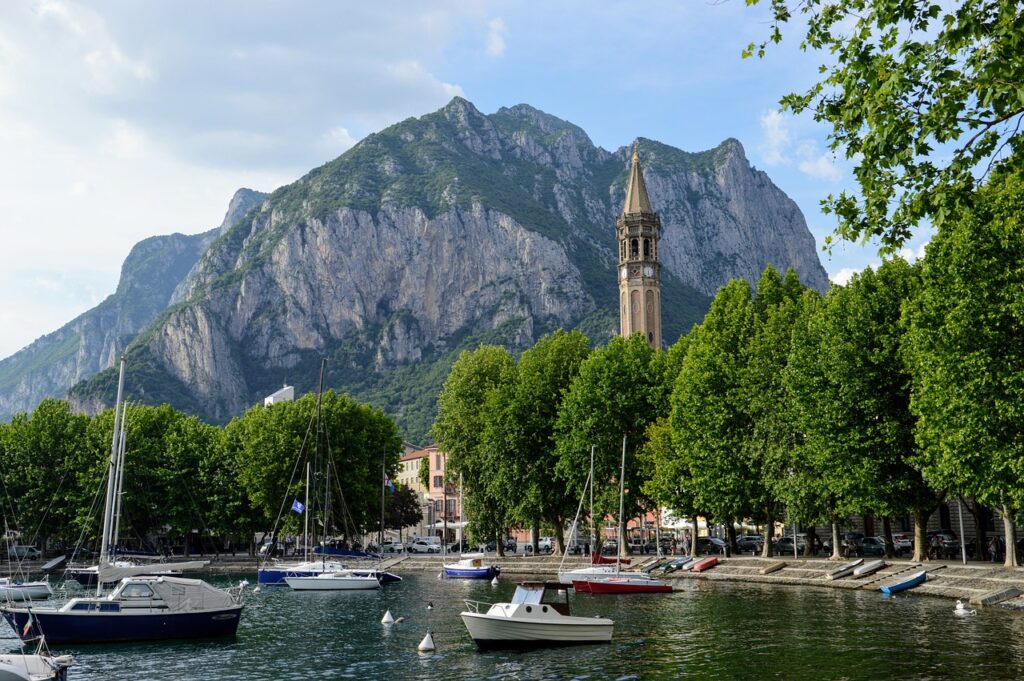
Lecco is a beautiful lakeside town characterised by pretty streets and vine covered balconies overlooking charming courtyards below. It’s worth spending time just meandering along the lakeside promenade, making the most of the wonderful views along the southern fork of Lake Como, after which you can make your way into the historic centre.
There is much to admire here including the neoclassical Teatro della Societa in Piazza Garibaldi and the Medieval Torre Viscontea in Piazza XX Settembre. The latter was commissioned by Azzone Visconti in the 16th century but now only the ruins remain. Both this piazza and the Piazza Zermanati are bustling with people and are great places to grab a coffee from one of the cafes and simply enjoy some people watching! Also of note is the 14th century Visconti Bridge (or Old Bridge) and the 96 metre high octagonal bell tower that dates back to 1904 but occupies the site of a Medieval bell tower that stood there previously.
There are also a number of impressive 18th and 19th century villas in Lecco including Villa Manzoni on Via Amendola. As the same would suggest, it was where Italian poet, novelist and philosopher Alessandro Manzoni was born. These days, it’s a museum celebrating his life and works. There is also a statue of Manzoni in the town by artist Francesco Confalonieri.
Lecco is the setting for Manzoni’s 1827 novel The Betrothed (I Promessi Sposi). Those familiar with the book will recognise parts of Lecco that he mentions including the Chiesa dei Santi Materno e Lucia with its bell tower. This may look quite plain from the outside but is actually one of Lecco’s oldest churches and its Baroque interior is quite impressive. Other religious buildings in Lecco include the Basilica of Saint Nicholas and the Sanctuary of Our Lady of Victory.
Finally, before you leave Lecco, head up the cable car that goes from Lecco to Piano d’Erna. The views from here are absolutely superb and well worth the trip. You can either catch the cable car back down again afterwards or alternatively, set aside a couple of hours to walk back.
Lenno
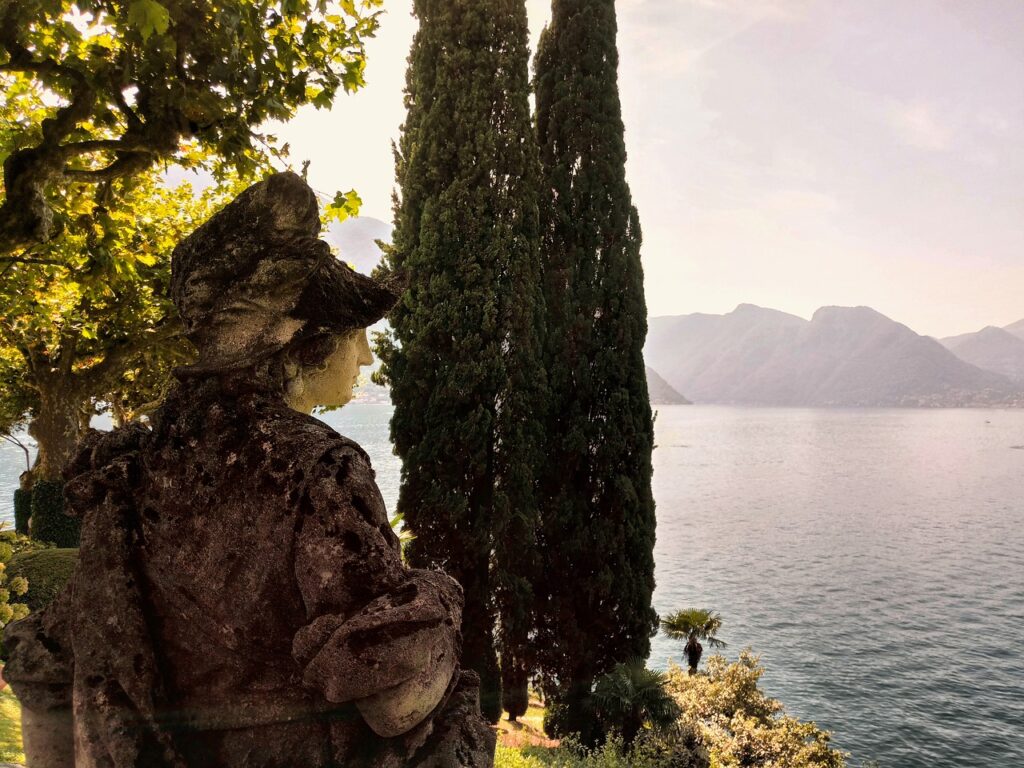
Lenno is home to a number of stunning villas including Villa Cassinella di Mantegazza and the most famous of all, Villa Balbianello. This villa was once privately owned but is now part of the equivalent of the National Trust of Italy (Fondo per l’Ambiente Italiano). If you think you recognise the house and its gardens, then it’s probably because you have seen it in a film set. It has been the backdrop of many films including the 2002 epic Star Wars: Attack of the Clones, the 2006 Bond film Casino Royale and A Month by the Lake. The villa is famous for its intricate terraced gardens which are a delight to explore. Either head to the villa on foot along the 1 km long pathway that starts at the Via degli Artigiani or head there by boat from Lenno’s public beach. If you do go on foot, you’ll pass by Lenno’s pebbled beach en route.
Lenno’s history actually stretches far back beyond the time when these villas were built though and certainly existed in Roman times. In fact, the vineyards and olive groves you find here owe their existence to the Roman cultivation of these foodstuffs.
Otherwise, it’s worth finding the time to visit the 12th century Acquafredda Abbey a short walk away, the Church of Saint Stephen and the Church of Saint Vincent in nearby Portezza. In Lenno itself, you may also want to make sure you pay your respects at the war memorial in the Piazza XI Febbraio. Lenno is one of Italy’s most decorated cities when it comes to the local partisans’ bravery during World War II.
Loppia
`Loppia is a delightful little village just a short drive from Bellagio. Look out for the traditional ringed top fishing boats (Lucie) in the harbour and the Santa di Loppia Church.
Malgrate
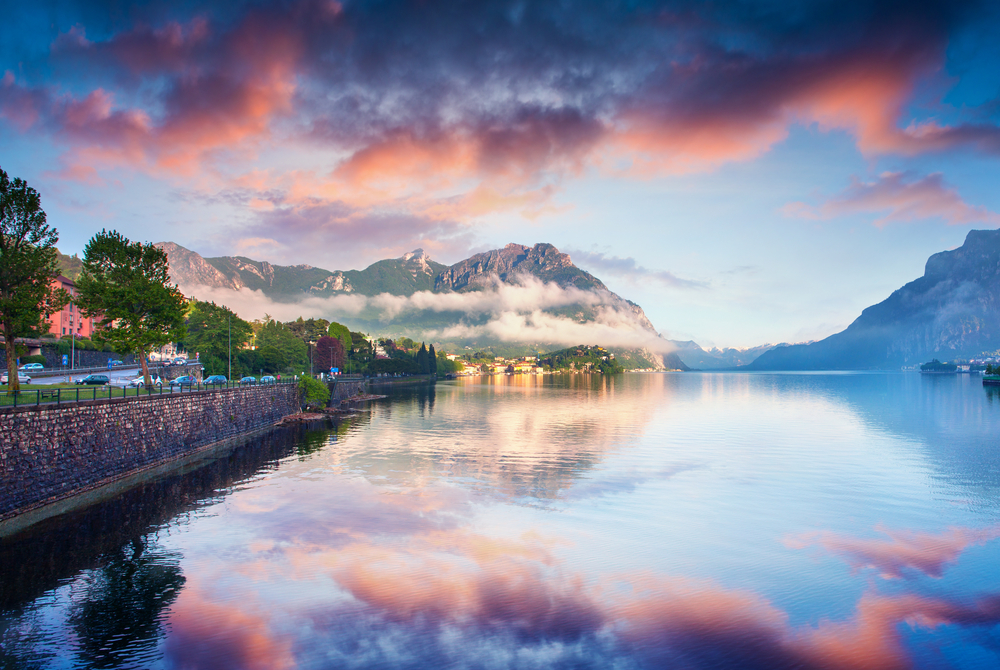
Considerable investment has been made into Malgrate’s waterfront over recent years and the lakeside promenade now has a contemporary feel with modern sculptures and artwork breaking up the view across the lake towards Lecco. In one section there is a beach area.
Otherwise, there isn’t much to see in Malgrate apart from some religious buildings. These include a small chapel – the Cappella dei Morti di Peste, home to the bodies of those who died in this area from the Black Death in the 16th century, the Church of Sant Antonio Abate, the 16th century Church of San Leonardo with its three bell towers and the Church of San Carlo al Porto.
Mandello del Lario
Mandello del Lario is perhaps most famous for being the home of the Italian motorbike company, Moto Guzzi. For those with an interest in motorcycle production, head to the Moto Guzzi Museum in Via Parodi which boasts over 150 exhibits bringing to life this industry and the history and designs of this brand. If you’re not a fan of motorsports, but like the water, Mandello del Lario is also a good place to go if you’re a keen sailor with an excellent sailing school.
There are a couple of other buildings worth visiting such as the Church of San Lorenzo which you will find in the heart of the town, the 11th century Romanesque Church of San Giorgio with its 15th century frescoes and the Sanctuary of the Madonna del Fiume with a Renaissance style exterior and contracting Baroque interior. It’s also possible to glimpse evidence of Mandello del Lario’s Roman origins in the Torre di Pretorio, an old Roman tower. Elsewhere in the town, there are some impressive liberty style villas, evidence of the town’s popularity amongst holidaymakers since the early 1900s.
Also worth seeing is the Grotta Ferrera. This is a huge cave approximately 175 metres long and 50 metres high with an underground stream and waterfall. And finally, if you have the time, head to the small hamlet of nearby Maggiana which overlooks Mandello del Lario. This is where you will find the Medieval Torre del Barbarossa, the home of Federico I nicknamed il Barbarossa (Red Beard) in the 12th century and now where you’ll find a rural museum, open on request.
Menaggio
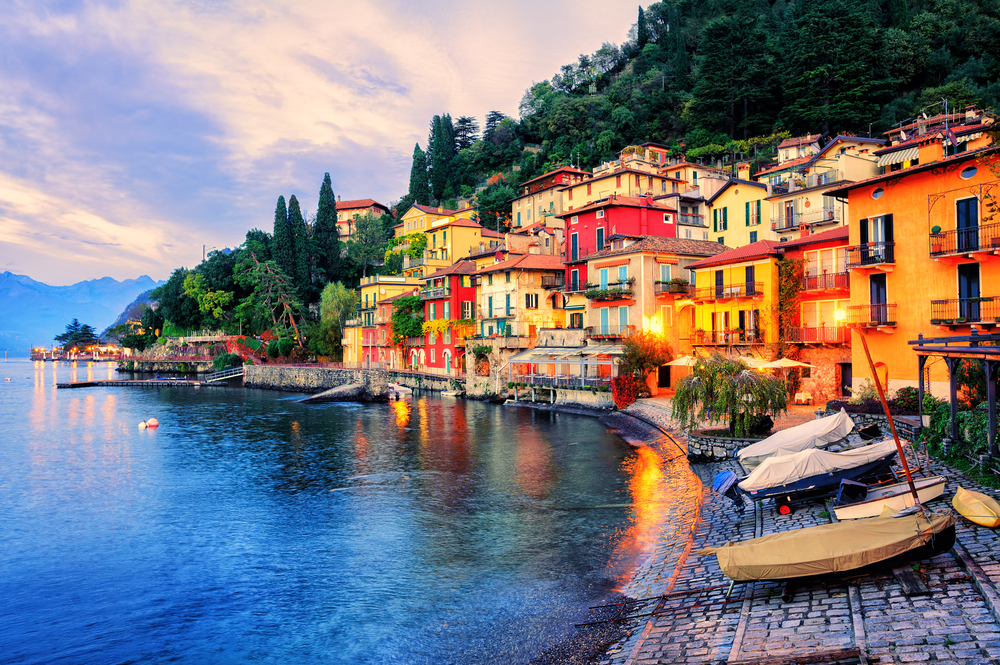
Menaggio is a popular town, with a lido and a very attractive lakeside promenade dotted with flowerbeds and palm trees. Also on the lakefront is the prominent 10 metre tall, white Carrara marble statue of the female silk weaver (Monumento alla Tessitrice). It was commissioned by the Mantero family, owners of a nearby silk mill and made in 1990 by Francesco Somaini.
Enjoy a coffee in the lakeside Piazza Garibaldi and take in the beautiful views before taking a stroll along the Via Calvi where you’ll find a number of lovely shops selling everything from shoes to homewares and from clothing to food. You’ll also find the Church of Santa Marta and its 17th century paintings. Head back from the lake and you’ll discover the old town of Menaggio with its more medieval look, narrow alleyways, steep stone steps and buildings. The very oldest part of the town is in the Via da Castello where you can take a walk along the huge perimeter walls that once bordered an ancient castle that has long since been demolished.
Keep walking and head to the Via Strecium to admire the pretty bridge that goes from one side of the Senagra stream to the other, above the waterfall that drops below.
Moltrasio
The town of Moltrasio is made up of 11 villages in total – Borgo, Casarico, Carisciano, Creolino, Somaino, Luscesino, Vignola, Casarevolo, Roiano, Tosnacco, Vergonzano, and Vighinzano. It has been popular with holidaymakers and high profile figures for centuries. Bellini often visited the town and, in fact, composed his opera La Straniera at Villa Salterio. An equally impressive villa in the town is Villa Passalacqua which saw a string of illustrious guests including Napoleon and Winston Churchill. More recently, Villa Fontanelle in Moltrasio was the home for Gianni Versace.
Arrive in Moltrasio by boat and you will find yourself in Piazza San Roco. Head south of here to reach a small beach whilst or head north to reach the harbour. Alternatively, continue along the Via Fratelli Recchi uphill towards the main village. It’s really picturesque and there’s even a waterfall along the way! This waterfall – the Cascata del Torrente Pizzallo – is in the very heart of the village, flowing over the rocks and through the village. Little bridges allow residents to successfully cross it during heavy rain.
Look out for some of the village churches en route including the Church of Sant’ Agata and the Church of San Martino. Visit the village in November at the time of the feast of San Martino, the town’s patron saint, and you will be able to browse the stalls selling handmade goods and local produce.
Nesso
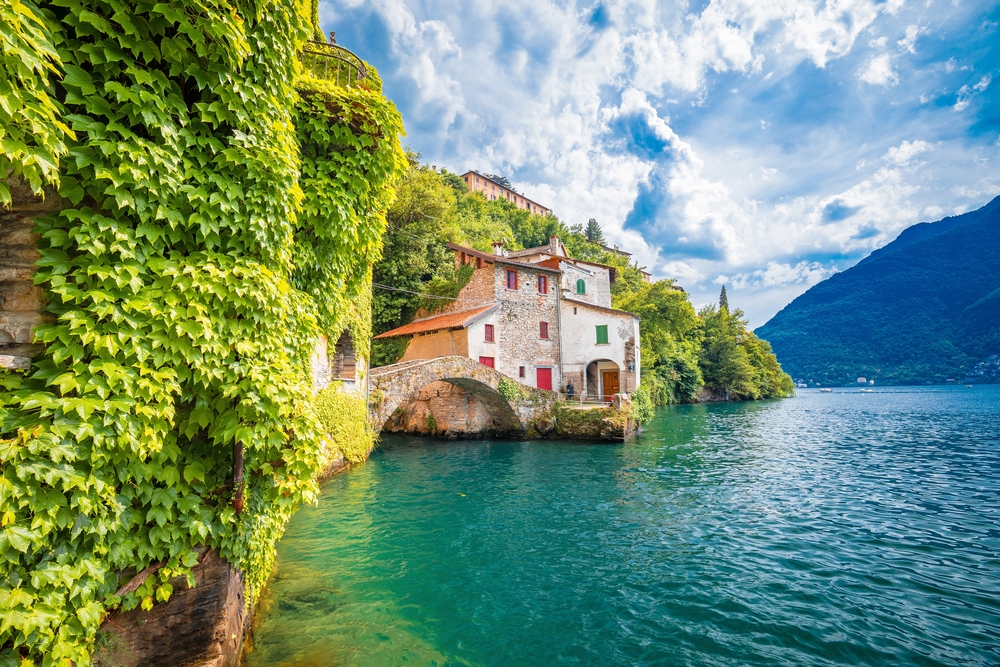
A beautiful lakeside town, Nesso is extremely picturesque, characterised by narrow alleyways, steep little streets and lots of steps! Wander around and discover the Church of Saint Pietro and Paolo. There was a church in this spot as early as 1095 however what you see today dates to the 17th century.
The heart of the village is the Piazza Castello. From here, you will hear the sound of the waterfall in the nearby Orrido di Nesso (Nesso gorge). The best place to view this waterfall is up 340 steps from the piazza to the Ponte della Civera, a beautiful Romanesque stone bridge.
Ossuccio
Ossuccio is a pretty village positioned opposite Comacina Island with pastel coloured houses set behind the lake where you’ll find boats bobbing on the water. Incidentally, this is a great place to catch a boat over to the island. Head to the edge of the town by the Perlana river and you will also be able to catch a glimpse of the exterior of the Villa del Balbiano, a stunning 16th century villa that sadly is not open to the public.
Ossuccio is most famous for being home to the UNESCO World Heritage site, the Sacro Monte. This is a group of mountain chapels and sanctuaries which are scattered throughout the area. Successfully combining two distinct styles – Renaissance and Alpine – the Sacro Monte has been an important site for pilgrims since the 17th century.
Also worthy of a visit is the Romanesque Church of Santa Maria Maddalena. Whilst the main body of the church dates back to the 11th century, the most striking thing about this building is the later addition of the narrow 15th century Gothic bell tower with its belfry.
The second church worthy of a visit is the 12th century Church of Saint Euphemie, with various additions in the 14th, 17th and 19th centuries as well as renovations in the late 20th century. The church is home to the 7th century tombstone of Bishop Agrippino which was brought here from Isola Comacina.
There is also the 12th century Church of San Giacomo, home to a number of ancient frescoes.
Finally, whilst here, we recommend you enjoy a walk to the San Benedetto Abbey. The walk will take about 4 hours but is well worth it.
Perledo
Perledo is not a big place but we think it’s worth a visit nonetheless. The main attraction is certainly its church – the 11th century Church of San Martino – with its Romanesque bell tower and Baroque facade that was a later addition in the 16th century. Other churches in Perledo include the Church of Sant’ Antonio and the Chapel of Santa Maria Gittana.
Take a short stroll out of Perledo to the nearby hamlet of Vezio to admire the Castello di Vezio that sits atop a hill enjoy breathtaking views of the surrounding countryside.
Pescarenico

Pescarenico is a small 16th century fishing village on the banks of the River Adda which feeds Lake Como. The village is still home to fisherman whose nets you will see drying in the sunshine. They fish in the River Adda and Lake Garlate, supplying local restaurants with their catch.
Pianello del Lario
Yet another charming lakeside town, Pianello del Lario has a nice beach area, perfect for water sports and sunbathing. The town also boasts a good selection of shops and restaurants and an interesting Renaissance church – the Church of San Martino. However, the town also plays an important role in keeping the sailing history of Lake Como alive, though the Museo della Marca Lariana (Museum of Larian boats). This museum tells the story of the boats built on Lake Como including everything from fishing vessels to sailing boats and from gondolas to canoes.
Head to Pianello del Lario at Easter to enjoy its annual regatta.
Pigra
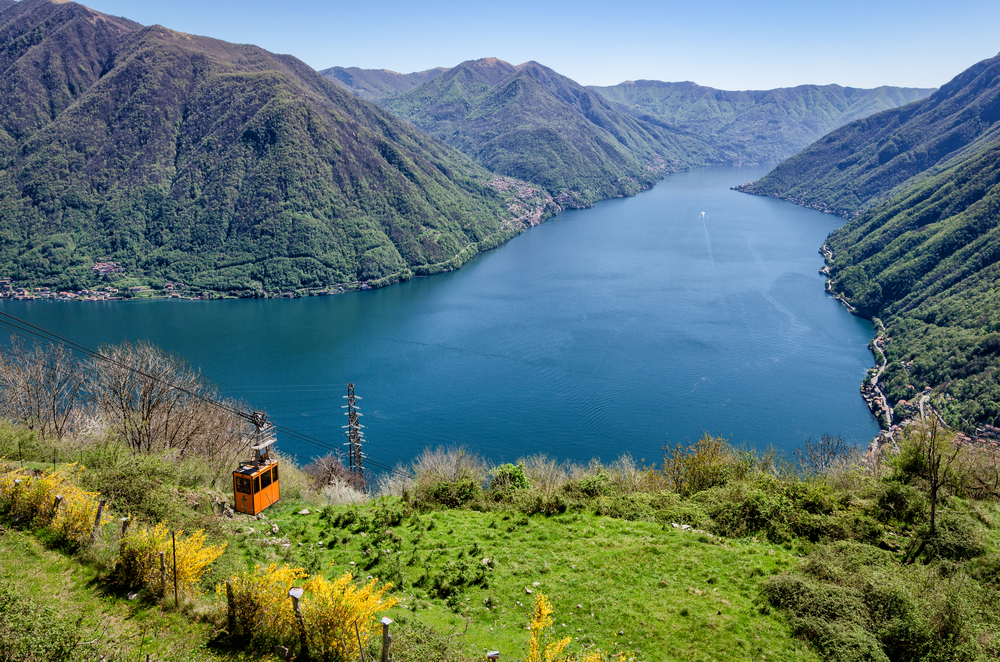
A cable car takes visitors from Argegno to the small village of Pigra approximately 880 metres above sea level in just 5 minutes at a speed of 5 metres per second. In fact, this is one of Europe’s steepest cable cars. From here, you can enjoy wonderful views of the lake and surrounding mountains. Follow the path uphill a little further to the Belvedere for even more impressive views. Or take time to explore Pigra itself. The 16th century Church of Santa Margherita is of interest as is Al Cason. This is now a museum but was once the headquarters of the Pigra Workers Society of which Giuseppe Garibaldi was a member.
Plesio
Plesio sits 600 metres above sea level above the larger town of Menaggio below. Its high position means that you’re guaranteed to enjoy great lake views. It’s a great starting point for hikers wishing to explore more of this area on foot in the mountain districts such as Monte Grona, Monte Bregagno and the Alpe di Nesdale. From these peaks you can get a superb view of the Y shape of Lake Como with Bellagio in the middle of the two ‘legs’.
Not surprisingly, there are some religious buildings of note in the area such as the Church of San Fedele, the Church of Mary Magdalene in Barna and the Church of San Gregorio Breglio. From here, you can enjoy a 30 minute walk along the mule track to the Chapel of San Domenico di Breglia. This sits 800 metres high above the lake and offers one of the best views of Lake Como you can find anywhere.
Pognana Lario
Pognana Lario is another town on Lake Como that is divided into different hamlets – Canzaga, Pognana, Quarzano, Riva and Rovasco. Some of these certainly existed as far back as Roman times thanks to the discovery of Roman tombs in Pognana. More recently, the town was famous for is Moltrasio stone mines, producing stone easily recognised by its grey-blue streaks of colour.
Must see sites include the 12th century Church of Saint Miro in Rovasco, home to Byzantine frescoes depicting St Christopher and the Madonna with Child, and the Church of Saint Rocco containing early 15th century frescoes by Bartolomeo de Benzi.
Head to Pognana Lario on 16 August each year to join in the celebrations around the Gnocchi Festival held at this Church. Or, head to Quarzano on the first Sunday after Easter to enjoy the rather delicious Festival of Cakes.
Sala Comacina

Sala Comacina is a small lakeside village whose historic centre is pedestrianised. It won’t take long to explore but is still well worth a visit to explore its narrow streets and charming piazzas – Piazza Caprani, Piazza XXV Aprile and Piazza Matteotti. Also in Sala Comacina is Villa Rachele, a beautiful villa that over the years has had many famous guests including Alessandro Manzoni and Italian historian, Cesare Cantu.
It’s possible to enjoy a boat trip from the harbour in Sala Comacina across to Isola Comacina which sits directly opposite the village.
Sorico
A popular spot on the Lake Como tourist trail, Sorico is home to the Pian di Spagna nature reserve, an area of outstanding natural beauty. Certainly, many tourists are attracted here because of its outdoor activities – hiking trails, water sports and beaches.
There are also a number of buildings of cultural interest in Sorico. The Church of Santa Stefano proudly stands in the centre of the town whilst the Sanctuary of San Miro sits on a hilltop overlooking it. Also overlooking the town are the ruins of the Castello di San Giorgio with its Medieval watchtower. Slightly further away in the hamlet of Bugiallo is the Church of San Giovanni Battista and in Dascio is the Church of San Biagio.
Sorico hosts a number of festivals throughout the year.
Torno

Torno is made up of four separate villages – Montepiatto, Perlasca, Piazzaga and Rasina. The town dates back pre Roman times however it prospered most in the Medieval period thanks to the production of wool, textiles and tapestry. Unfortunately, this put it in direct competition with nearby Como and in 1522, Como successfully destroyed Torno’s fortifications and devastated the small town, wiping out their competition. Luckily, two churches survived the destruction – the lakeside Church of Santa Tecla and the Church of San Giovanni in Torno’s centre. A number of beautiful villas post date the siege including the 16th century Villa Pliniana, Villa Taverna (famous for its gardens) and Villa Mia. Villa Pliniana has had some very famous guests over the years including Napoleon, Rossini and Lord Byron.
As well as exploring Torno itself, we can recommend the 45 minute walk from Torno to Montepiatto. Here you will find the Church of Saint Elisabeth as well as the Pietra Pendula rock formation.
Tremezzo
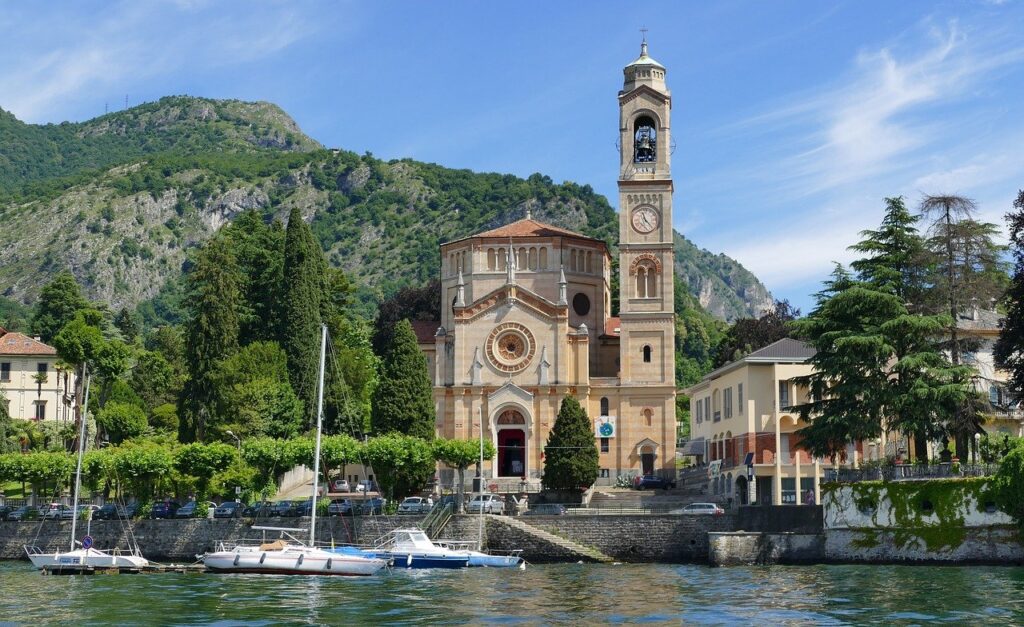
Tremezzo sits almost directly across from Bellagio on the other side of Lake Como. It’s popular with tourists who stay in its famous hotels that date from the 18th and 19th centuries such as the Grand Hotel Tremezzo. It is also famous for its historic villas including Villa La Quiete and Villa La Carlia. However, by far the most famous of its villas is Villa Carlotta.
Villa Carlotta is just as interesting inside and out. Its interior is furnished and decorated in the 17th century neo-classical style with a number of beautiful tapestries, paintings and artworks. Outside, its gardens are simply beautiful. Our favourite time to visit is in the Spring and early Summer when you will find the azaleas, camellias and rhododendrons in full bloom however it has been cleverly planted to ensure that, whatever time of year you visit, it will still look magical.
There are a small number of religious buildings to visit in Tremezzo too including the Church of Santa Maria where you can admire the beautiful statue of Madonna Nera that it’s home to. Also make sure you visit the Church of Saint Bartholomew, a 12th century church that was rebuilt in the 17th century. Whilst 90% of Tremezzo’s buildings sit on the shores of the lake, there is just as much to admire inland too. For example, if you take the track next to this church (called the Selve di Rogaro) you will have the chance to discover the ancient tower and remains of an old Medieval fortress with panoramic views across the lake.
Please note: You may sometimes hear this area referred to as Tremezzina, a name that came about from the amalgamation of Lenno, Mezzegra, Osuccio and Tremezzo in 2014.
Valmadrera
Valmadrera dates back to Roman times however what you see today originates from the 12th century onwards. The town has seen the rise and fall of a number of wealthy families over the years, each of which has contributed in some way to making the town what it is today. These include the Mandelli family, the Bonacina family, the Fatebenefratelli and the Gavazzi. This family played an important part in the silk industry which played a prominent role in the town’s economy from the end of the 18th century onwards.
Saint Antonio Abate is the town’s patron saint and he is celebrated on 17 January each year. Whatever time of year you are in Valmadrera though, you can visit the Church of San Antonio Abate. While much of the building dates to the 19th century, its bell tower predates this and was constructed in the 16th century, once part of a previous building that stood on the same spot.
Varenna
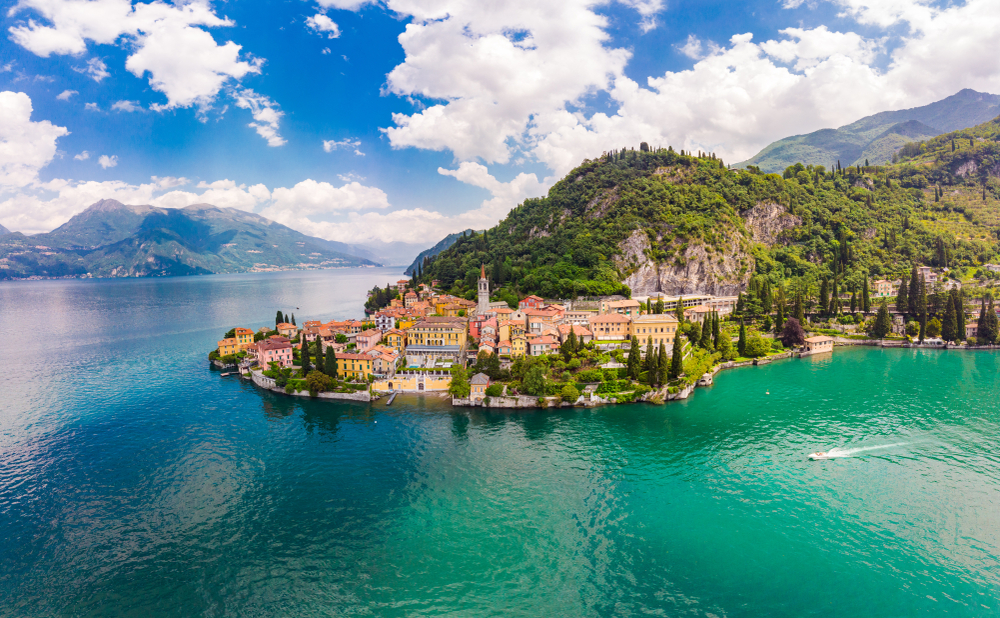
A trip to Varenna during your stay on Lake Como is not to be missed. Take a stroll along the colourful lakeside Riva Grande, pop into Varenna’s charming shops and cafes, spend time in the town’s principal villas and their gardens – Villa Monastero and Villa Cipressi – or take a stroll through Varenna’s main square – Piazza San Giorgio… . Whatever you choose to do during your time in Varenna, you won’t be disappointed. Varenna is all too often unfairly eclipsed by its more famous neighbour, Bellagio, but don’t let it be!
Check out our Varenna travel guide for more information.
